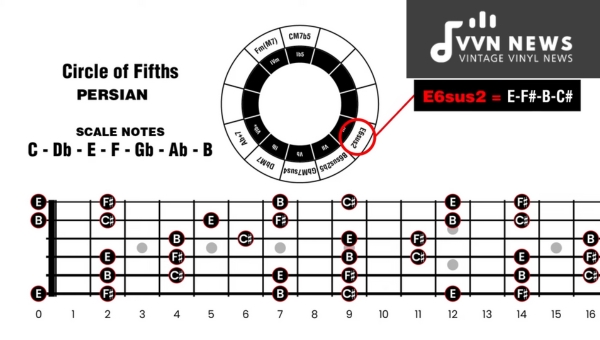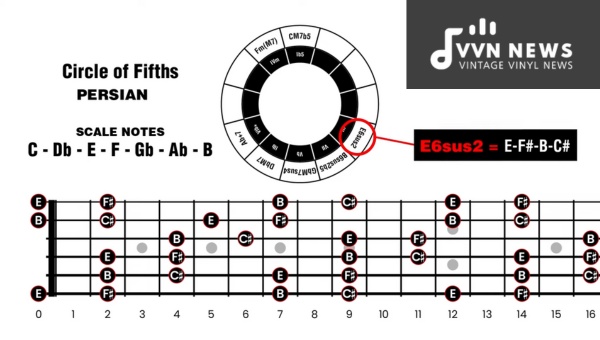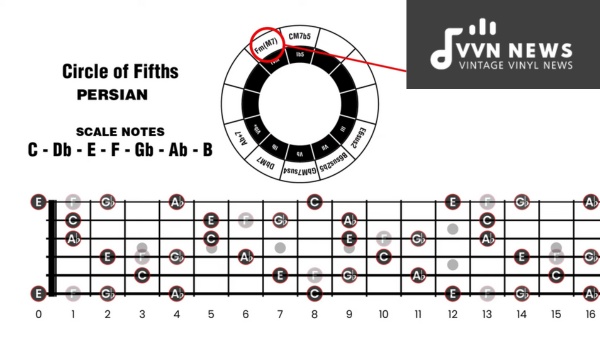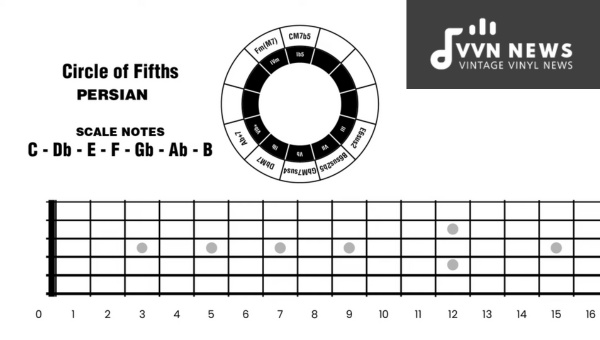As a musician, I’m sure you’ve heard of the circle of fifths – that handy tool that helps us navigate through the world of music theory.
But have you ever stopped to explore the fascinating world of seventh chords within the circle of fifths?
We’ll dive deeper into this concept and unlock a whole new layer of musical possibilities.
Seventh chords are a staple in modern music and add depth, color, and tension to our compositions.
By understanding how they relate to the circle of fifths, we can easily construct and identify these chords in any key.
So, let’s embark on this musical journey together and discover the magic behind the circle of fifths seventh chords.
the Circle of Fifths for Chord Building
The circle of fifths is a powerful tool that helps us navigate through the intricate world of music theory.
It is a visual representation of the relationship between keys and their corresponding major scales. By understanding how it works, we can easily build chords and progressions.
- The circle is constructed by starting with the key of C major at the top and moving clockwise in ascending fifths (or counterclockwise in descending fourths).
- Each key on the circle is represented by its letter name.
- Moving one step clockwise (or counterclockwise) represents going up (or down) five steps in the cycle.
- Major scales are built using this cycle: C, G, D, A, E, B, F#, Db/Gb, Ab, Eb, Bb, and F.
- From each major scale within the circle, we can build chords by taking every other note from that scale.
- The most common chords built from these scales are triads – three-note chords consisting of the root note, third note (major or minor), and fifth note.
- By using the circle of fifths as a guide, we can add another layer to our chord-building process by incorporating seventh intervals.
Understanding how to navigate the circle of fifths lays a strong foundation for chord building and enables us to create interesting and complex harmonies in our compositions. Next in our exploration will be how to utilize this knowledge specifically for constructing dominant seventh chords.
Also Read: Beaming In Music [Guide To Reading And Understanding Them]
Using the Circle of Fifths for Dominant Seventh Chords

Dominant seventh chords are an essential component of music theory, adding tension and creating a sense of resolution in our compositions.
By utilizing the circle of fifths, we can easily construct dominant seventh chords in any key.
To build a dominant seventh chord using the circle of fifths, follow these steps:
- Identify the key: Determine the key you want to work with and locate it on the circle of fifths.
- Find the fifth: Move clockwise on the circle to find the key that is a perfect fifth above your chosen key. This will be the root note of your dominant seventh chord.
- Formulate the chord: Once you’ve identified the root note, add intervals of a major third and a perfect fifth above it. For example, if your root is C, add an E (major third) and G (perfect fifth).
- Add the dominant seventh: To complete your dominant seventh chord, lower the seventh note by a whole step from where it naturally falls in the major scale. In our C example, this would be B♭.
- Notate and play: Write down or play the four notes together – C E G B♭ – and listen to how they create that distinct dominant sound.
By following these steps within the framework of the circle of fifths, you can easily construct dominant seventh chords in different keys without having to rely on complex formulas or memorization.
This knowledge opens up countless possibilities for creating tension and resolving it harmonically in your compositions.
Locating Major Seventh Chords with the Circle of Fifths
When it comes to major seventh chords, the circle of fifths provides a simple and intuitive way to find and understand their construction.
Major seventh chords consist of four notes: the root (1st), major third (3rd), perfect fifth (5th), and major seventh (7th).
These chords have a distinctive sound that evokes a sense of sophistication and elegance.
To locate major seventh chords using the circle of fifths, follow these steps:
Step 1: Identify the key
Determine the key of the major seventh chord you want to construct. The key tells you which notes are in play and helps establish the tonal center for your composition.
Step 2: Find the corresponding key on the circle of fifths
Locate the key on the outer rim of the circle. This will serve as your starting point for constructing the major seventh chord.
Step 3: Move clockwise to find the root note
Follow along the circle in a clockwise direction until you reach your desired root note. The root note is crucial as it determines which note will serve as the foundation for your major seventh chord.
Step 4: Build your major seventh chord
Tallying up intervals from your root note, add a major third (M3) above it, followed by a perfect fifth (P5) above that. Finally, add a major seventh (M7) above your root note to complete your major seventh chord.
By following these steps, you can easily locate and construct major seventh chords using the circle of fifths.
This tool not only simplifies chord building but also enhances your understanding of harmonic relationships within music theory.
Understanding how major seventh chords fit into different keys can open up new possibilities for creating captivating melodies and harmonies in your compositions.
Also Read: Tones And Semitones [Decoding The Language Of Music]
Importance of Seventh Chords in Composition and Harmony

Seventh chords are a powerful tool in the realm of music composition and harmony, providing richness and complexity to our musical creations.
They add a unique flavor and emotional depth that can elevate any piece of music.
Enriching the harmonic palette
By incorporating seventh chords into our compositions, we expand the range of harmonies at our disposal.
These chords go beyond the traditional major and minor triads, introducing new tonal colors and possibilities.
The addition of the seventh note adds tension and resolution, creating a sense of forward motion in the music.
Creating tension and resolution
Seventh chords are renowned for their ability to create tension and release. The dissonance introduced by the added seventh note generates a desire for resolution, which can be achieved by moving to another chord in a progression.
This interplay between tension and resolution adds intrigue, dynamics, and emotional impact to our compositions.
Enhancing melodic movement
Seventh chords offer melodic options that extend beyond what simple triads can provide.
The additional notes present in these chords allow for more intricate melodic lines and movements within a composition.
By utilizing these expanded intervals, composers can craft melodies that are more expressive and memorable.
Supporting complex harmonies
In complex pieces where multiple harmonic voices interact, seventh chords serve as invaluable building blocks for rich harmonies.
They provide stability within chord progressions while adding layers of complexity to the overall sound. This is especially true when exploring jazz or contemporary music genres.
Adding sophistication to arrangements
When arranging music for various instruments or ensembles, incorporating seventh chords helps bring sophistication to the overall sound.
Whether it’s an orchestral arrangement or a jazz combo piece, these chords enhance the overall texture, creating lushness and depth that captivates listeners.
Seventh chords play a crucial role in composition and harmony by broadening our harmonic vocabulary, creating tension and resolution, enhancing melodic movement, supporting complex harmonies, and adding sophistication to arrangements.
Also Read: All About Figured Bass [The Foundation Of Baroque Music Theory]
Voice Leading with Seventh Chords in Progressions
When it comes to creating smooth and seamless chord progressions, the concept of voice leading becomes crucial.
Voice leading refers to the movement of individual voices within a chord progression, ensuring that they flow smoothly from one chord to another.
Seventh chords offer a rich palette for voice leading due to their unique harmonic structure.
The inclusion of an additional note (the seventh) introduces an extra layer of tension and resolution, adding complexity and interest to your progressions.
To utilize seventh chords effectively in voice leading, it’s important to understand how each voice moves from one chord to the next. Here are some points to consider:
- Root Motion: The movement of the root note creates a strong sense of key and direction. Aim for smooth transitions by choosing chords that have a close relationship in terms of key or intervallic distance.
- Voice Leading Rules: Observe proper voice leading rules where neighboring voices move by step (small intervals) and avoid creating large leaps between voices unless stylistically desired.
- Common Tones: Look for common tones between chords as they provide stability and continuity. Retaining at least one shared note helps smoothen the transitions and creates a bond between consecutive chords.
- Chord Inversions: Experiment with different inversions of seventh chords to create interesting voice-leading possibilities. Inversions allow you to choose alternative notes for each voice, providing more opportunities for smooth melodic lines.
- Seventh Resolutions: Pay special attention to resolving the seventh note within each chord, as it tends to create tension that craves resolution in subsequent chords. Resolving downward by step is a common practice, but experimenting with other resolutions can yield unique results.
By mastering voice-leading techniques with seventh chords, you can create more expressive harmonies smoother progressions, and evoke powerful emotional responses from your listeners.
Also Read: How To Transpose Up A Major Second? [Boost Your Music IQ]
The Role of Seventh Chords in Musical Expression and Emotion

When it comes to musical expression and emotion, seventh chords play a crucial role in creating an atmosphere that resonates with listeners.
These chords possess a distinct tonal quality that can evoke a wide range of feelings, from melancholy to excitement.
Let’s explore the various ways seventh chords contribute to musical expression.
- Tension and Resolution: Seventh chords introduce tension into a musical passage, creating an anticipation for resolution. The dissonance created by the added note in the chord adds complexity to the sound, capturing attention and heightening emotional impact. The resolution of this tension releases the built-up energy, eliciting a sense of relief or resolution.
- Richness and Color: Seventh chords bring richness and color to a composition, elevating the overall texture of the music. The extra notes added to a triad give the chord its characteristic sound and add layers of complexity that engage the listener’s ear. These harmonic nuances add depth and sophistication, enhancing the emotional impact of the music.
- Expressive Harmonic Movement: By incorporating seventh chords into progressions, composers can create intricate harmonic movements that make a piece come alive emotionally. The smooth transitions between different chord qualities further emphasize specific emotional themes within the music.
- Jazz and Contemporary Genres: Seventh chords are particularly prevalent in jazz and contemporary music genres such as blues, soul, funk, and R&B. These genres thrive on rich harmonies and expressive melodies, where seventh chords provide an essential ingredient for creating their signature sound.
- Melodic Enhancements: With their added notes, seventh chords offer melodic embellishments that can enhance a song’s overall beauty and expressiveness. A well-placed seventh chord can transform an ordinary melody into something extraordinary by infusing it with unexpected twists or turns.
Seventh chords have a significant impact on musical expression and emotion.
Whether used to create tension and resolution, add richness and color, or enhance melodic lines, these chords hold the power to captivate audiences and evoke a wide range of feelings.
Also Read: Musical Key Characteristics & Emotions [Understand Their Impact]
FAQs About Circle Of Fifths
How do I use the circle of fifths to build seventh chords?
To construct a seventh chord using the circle of fifths, start with the root of your desired key and move clockwise around the circle. Each step represents a fifth interval, and by adding the appropriate notes from your chosen key, you can form major, dominant, or minor seventh chords.
Can I use the circle of fifths to find dominant seventh chords?
Absolutely! By moving counterclockwise around the circle, you can locate the key that corresponds to the dominant seventh chord you want to create.
How can I find major seventh chords using the circle of fifths?
To find major seventh chords on the circle of fifths, move clockwise again from your root note. Each step represents a fourth interval this time.
Why are seventh chords so important in music composition?
Seventh chords add complexity and richness to musical compositions. They can convey a wide range of emotions and dramatically enhance harmonies and progressions.
What role do seventh chords play in voice leading?
Seventh chords are excellent tools for practicing voice-leading because they provide smooth voice-leading possibilities between different keys or adjacent chords within a key.
Conclusion
The circle of fifths is an invaluable tool for understanding and constructing seventh chords.
By utilizing this musical map, we can easily navigate through the world of music theory and unlock a whole new level of musical expression.
The circle of fifths allows us to build dominant seventh chords and major seventh chords with ease, enhancing our compositions with added depth and color.
By exploring the role of seventh chords in composition and harmony, we can create captivating progressions that evoke a range of emotions.
So, embrace the power of the circle of fifths and let it guide you on your musical journey.








